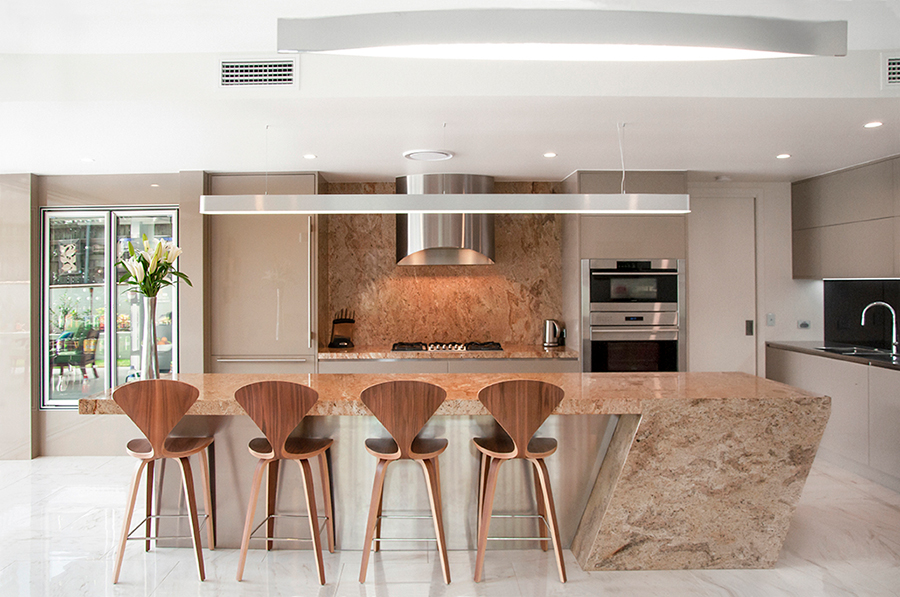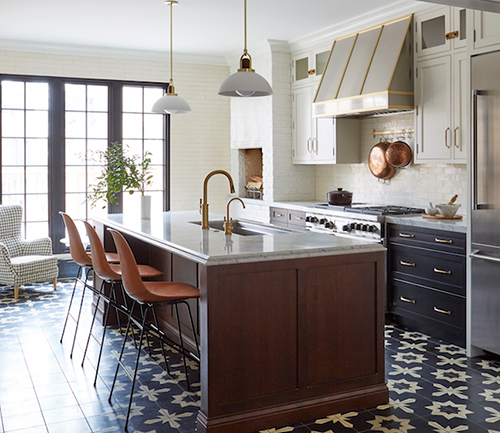
Image via ideiasdecor.com/Pinterest
Our kitchen is basically home HQ. A hectic morning hub, after-school gathering ground, pre-dinner prep zone, and a place where life happens and all the good goss goes down. So, it’s no surprise we’ve started craving a sense of personality for this well-loved, high-traffic space. First it was the warmth of timber. Now, cue colour. With a move away from all-white, we’re seeing the heart of the home enlivened with a custom palette of hues.
Imagine channelling a little colour-me-happy potential. Waking up to a splash of sunshine-yellow with your coffee. Coming home to a happy hit of green. Organising dinner with a calming backdrop of blue. Greeting guests will a playful pop of pink. “Colour plays a huge role in how a space can make you feel” says Kim Duffin, Principal Designer at Sublime Luxury Kitchens & Bathrooms. “With the kitchen now the main focus in many homes, the colour palette dictates not only the living space but often the whole home.”
TIP: “Most people find that the favourite hue in their wardrobe flows through to their surroundings” Kim Duffin, Sublime Luxury Kitchens & Bathrooms

Image: Sublime Luxury Kitchens & Bathrooms
What’s my colour?
If a pea-green kitchen will make your heart sing, then what’s holding you back? See chef Rachel Khoo’s example for all the incentive you need. Or perhaps bringing home that 50s-style Smeg fridge in Pastel Green (yes, the awesome retro one) will complete the picture. All bets are off when doing your own kitchen. “The colour only has to make sense to the owner as they are the one living in it,” says Stuart May, designer at Style Kitchens by Design. Look to your living spaces and outdoor surroundings, especially if your kitchen has a feature window, and even your wardrobe for ideas.
TIP: Colour can be subtle or showy. Amplify the energy with bold colours and high-impact features or dial it back with soft hues and a light touch.

Credit: Rachelkhoo.com
Remember to blend
Just keep in mind, even a strong personal choice works best within a well-considered scheme. Stuart names ‘out on their own’ choices as one of the biggest pitfalls when working with colour. For example, “when you have a basic white kitchen and choose a red splashback — but have no other ties to red in the space.” One way around this is pulling even a tiny accent colour from one area and marrying it with the new hue. “So, a golden vein in your marble might blend with a pop of yellow,” he explains. This is where your ‘accessorising’ elements might also come into play, balancing a more dramatic colour statement with touches of a similar or complementary tone.

“Take inspiration from colours used in adjoining spaces to create a cohesive look,” suggests Kim. This way, your kitchen won’t exist in a style vacuum. When it comes to choosing your palette, “select complementary colours (eg. blue/orange), even using a colour wheel, or use colour in sections or colour blocks,” he says.

Related article: An innovative and high-impact colourful kitchen design
TIP: “Even for a bold statement, the base of the colour tones needs to work with the overall scheme.” Stuart May, Style Kitchens by Design

How to: accessorise with colour
Will a splash be enough? Then consider quick-change colour ways. Colourful upholstery is still trending (think bar stools, dining chairs or booth seating) while artwork, pendant lights, and bench appliances create personality and depth in even the most utilitarian spaces. These non-permanent elements can bring life to a white kitchen, notes Stuart. “Feature appliances or cooking items, artwork etc are great extras that can really work… but you’ll also have the ability to swap or hide them, which will instantly change the overall look.”

TIP: Don’t forget your textiles and fabrics — a printed kitchen blind, floor rug or even linen dish clothes can bring the colour (and flexibility) you crave.

Related article: Kitchen and bathroom design with bespoke style
How to: commit to colour
Want to go a step further? Colourful cabinetry is having a major moment, with deep navy, petrol blue and green tones dominating our Pinterest boards. Illuminated stone, usually in an island bench or wall feature, will also bring a dynamic and artistic touch that really shines after dark. Bringing colour through to your splashback, island, cabinetry, wall paint or even floor tiles requires a little more commitment — but the results are spectacular.
For a natural look, Kim from Sublime Luxury Kitchens & Bathrooms has a couple of suggestions. “I like to introduce colours via natural elements like granite or marble” he says. “Mother Nature has a way of creating the perfect hue or fusion of colours to highlight a grain or texture. We can also add colour through light fittings or even lighting itself, using changeable LED strip lighting.”

TIP: To highlight one colourful element, invest in concealed storage and tuck eye-catching details away. For a more integrated look, bring complementary colours and accents through homewares and other elements.

Make it personal
While you might be okay doing a seasonal swap on kitchen textiles and even bench accessories, more permanent colour should be a very individual choice. Your kitchen represents a significant investment, so it needs to stand the test of time. If in doubt, always opt for personal favourites over passing trends to create a kitchen you’ll still love in years to come.
TIP: “Make sure the owner of the space likes the colour and it’s not the designer’s personal favourite.” Stuart May, Style Kitchens by Design

See the light
While your chosen hue might look incredible on your phone, “because all lighting has a cast (warm, cool etc) it can present your own chosen hue in a different way,” says Stuart. The most foolproof approach is to work with your kitchen designer on an overall colour and lighting plan. “It\’s really important to consider any material or finish choice in all lights,” adds Kim. “So, morning, midday and afternoon natural light. Then under artificial lights: so warm, cool and neutral tones.” If you’re adding colour to an existing scheme, be realistic about how your colour will actually look. You may be able to tweak your pendant bulbs or existing lighting to suit or add strategically placed strip lighting to highlight the new hue. Light can also be harnessed as a highlighting tool. “I also like to use different shades of mirror to bounce or reflect light around a kitchen that needs a lift from within,” says Kim.
TIP: “Even natural light from a window or door needs to be considered, especially if you viewed your chosen colour in a showroom with fluoro lighting.” Stuart May, Style Kitchens by Design




